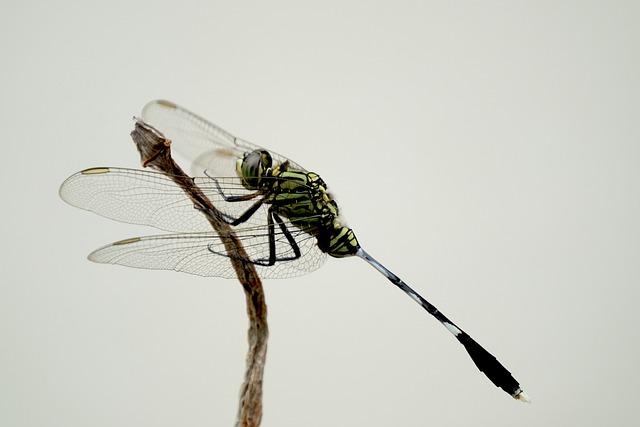The dragonfly is not specifically mentioned in the Bible, therefore it does not hold any symbolic meaning within biblical texts.
Table of Contents
Symbolism of Dragonfly in Biblical Texts
Dragonflies are fascinating creatures that have captivated humans for centuries. With their delicate wings and vibrant colors, they are often seen as symbols of beauty and grace. But did you know that dragonflies also hold a special meaning in the Bible? In this article, we will explore the symbolism of dragonflies in biblical texts and uncover the deeper spiritual significance they hold.
One of the first mentions of dragonflies in the Bible can be found in the book of Exodus. In this passage, Moses and the Israelites are wandering through the desert, and they encounter a plague of insects. Among these insects are swarms of dragonflies, which are described as being sent by God to torment the Egyptians. This event is seen as a divine intervention, a sign of God’s power and protection over his people.
In addition to their role in the plagues, dragonflies are also mentioned in the book of Psalms. In Psalm 104:24-25, the psalmist praises God for his creation, saying, “How many are your works, Lord! In wisdom you made them all; the earth is full of your creatures. There is the sea, vast and spacious, teeming with creatures beyond number—living things both large and small.” This passage highlights the diversity and abundance of God’s creation, including the dragonfly.
The dragonfly’s symbolism in the Bible goes beyond its role in specific passages. It is often associated with transformation and change. Just as a dragonfly undergoes a metamorphosis from a nymph to a fully grown adult, so too does the believer undergo a spiritual transformation when they accept Jesus Christ as their savior. The dragonfly serves as a reminder of the transformative power of God’s love and the new life that comes with it.
Furthermore, the dragonfly’s ability to fly and hover above the water is seen as a symbol of spiritual insight and discernment. In the book of Job, Job is encouraged to seek wisdom and understanding from God, who is described as being “above the waters.” This imagery suggests that just as the dragonfly hovers above the water, believers should strive to rise above the mundane and seek a deeper understanding of God’s truth.
The dragonfly’s association with water is also significant in biblical symbolism. Water is often used as a metaphor for the Holy Spirit and the cleansing power of God’s grace. In the New Testament, Jesus tells his disciples that those who believe in him will have “rivers of living water” flowing from within them. This living water represents the Holy Spirit, who brings refreshment and renewal to the believer’s soul. The dragonfly, with its close connection to water, serves as a reminder of the transformative and life-giving power of the Holy Spirit.
In conclusion, the dragonfly holds a special meaning in the Bible. It is a symbol of God’s power and protection, as seen in the plagues of Egypt. It represents transformation and change, reminding believers of the new life they have in Christ. The dragonfly’s ability to fly and hover above the water symbolizes spiritual insight and discernment, while its association with water represents the cleansing and renewing power of the Holy Spirit. So the next time you see a dragonfly, take a moment to reflect on its deeper spiritual significance and the messages it carries from God.
Dragonfly as a Sign of Transformation in the Bible

Dragonflies are fascinating creatures that have captivated humans for centuries. With their delicate wings and vibrant colors, they are often seen as symbols of beauty and grace. But did you know that dragonflies also hold a special meaning in the Bible? In this article, we will explore the significance of dragonflies as a sign of transformation in the Bible.
In the Bible, the dragonfly is not explicitly mentioned. However, many scholars believe that the dragonfly can be interpreted as a symbol of transformation based on the characteristics and behavior of this remarkable insect. Just like the dragonfly goes through a process of metamorphosis, from a nymph to a fully grown adult, it represents the transformative power of God’s grace in our lives.
The life cycle of a dragonfly begins in the water, where it lays its eggs. These eggs then hatch into nymphs, which spend a significant amount of time underwater. During this stage, the nymphs go through a series of molts, shedding their old skin and growing larger with each molt. This process can take several months or even years, depending on the species.
Once the nymph has reached its final stage of development, it crawls out of the water and clings to a plant or other surface. It then undergoes a remarkable transformation, shedding its exoskeleton and emerging as a fully formed adult dragonfly. This process is known as emergence and is often seen as a metaphor for rebirth and spiritual transformation.
In the Bible, there are several instances where transformation is a central theme. One of the most well-known stories of transformation is the conversion of Saul, who later became the apostle Paul. Saul was a persecutor of Christians, but after encountering Jesus on the road to Damascus, he underwent a radical transformation and became one of the most influential figures in the early Christian church.
Another example of transformation in the Bible is the story of the Israelites’ exodus from Egypt. The Israelites were enslaved in Egypt for many years, but with God’s intervention, they were able to escape and journey towards the Promised Land. This journey was not only a physical one but also a spiritual one, as the Israelites had to let go of their old ways and embrace a new life of freedom and obedience to God’s commandments.
Just like the dragonfly’s transformation, these biblical stories remind us that change is possible and that God’s grace can bring about profound transformation in our lives. Whether it is overcoming addiction, healing from past wounds, or finding a new purpose, the dragonfly serves as a powerful symbol of hope and renewal.
In conclusion, while the dragonfly is not explicitly mentioned in the Bible, its characteristics and behavior can be interpreted as a symbol of transformation. Just as the dragonfly goes through a process of metamorphosis, shedding its old skin and emerging as a fully formed adult, we too can experience a spiritual transformation through God’s grace. The stories of Saul’s conversion and the Israelites’ exodus remind us that change is possible and that God can bring about profound transformation in our lives. So, the next time you see a dragonfly, let it serve as a reminder of the transformative power of God’s love and grace.
Dragonfly as a Representation of Spiritual Growth in Christianity
Dragonflies are fascinating creatures that have captivated humans for centuries. With their delicate wings and vibrant colors, they are often seen as symbols of transformation and change. In the Bible, the dragonfly holds a special significance, representing spiritual growth in Christianity.
In Christianity, spiritual growth is a journey that believers embark on to deepen their relationship with God. It is a process of becoming more like Christ and aligning one’s life with His teachings. The dragonfly, with its remarkable life cycle, serves as a powerful metaphor for this transformative journey.
Just like the dragonfly starts its life as a nymph in the water, Christians begin their spiritual journey in the waters of baptism. Baptism symbolizes the cleansing of sins and the beginning of a new life in Christ. As the dragonfly nymph grows and develops underwater, Christians too must nurture their faith and seek spiritual nourishment through prayer, reading the Bible, and participating in worship.
When the time is right, the dragonfly nymph emerges from the water and undergoes a miraculous transformation. It sheds its old skin and emerges as a beautiful, winged creature. This process of metamorphosis mirrors the Christian’s journey of spiritual growth. As believers mature in their faith, they shed their old ways and habits, leaving behind their former selves and embracing a new life in Christ.
The dragonfly’s ability to fly is another aspect that resonates with the concept of spiritual growth. Just as the dragonfly soars through the air, Christians are called to rise above earthly concerns and strive for a higher spiritual plane. This means letting go of worldly attachments and focusing on the eternal values of love, compassion, and forgiveness.
Furthermore, the dragonfly’s ability to hover and change direction swiftly symbolizes the need for Christians to be adaptable and open to the leading of the Holy Spirit. Spiritual growth requires flexibility and a willingness to change course when necessary. It is about surrendering one’s own desires and allowing God to guide and direct one’s path.
The dragonfly’s vibrant colors also hold significance in the context of spiritual growth. In the Bible, colors often carry symbolic meanings. The dragonfly’s iridescent hues represent the beauty and diversity of God’s creation. They remind Christians that spiritual growth is not a one-size-fits-all process. Each individual’s journey is unique, and God works in different ways in each person’s life.
In conclusion, the dragonfly serves as a powerful symbol of spiritual growth in Christianity. Its life cycle, from nymph to winged creature, mirrors the transformative journey that believers undertake. Just as the dragonfly sheds its old skin and takes flight, Christians are called to let go of their old ways and soar to new heights in their relationship with God. The dragonfly’s ability to hover and change direction swiftly reminds believers to be adaptable and open to the leading of the Holy Spirit. And its vibrant colors symbolize the beauty and diversity of God’s creation, reminding Christians that each person’s spiritual journey is unique. So, the next time you see a dragonfly, take a moment to reflect on its meaning in the Bible and the profound message it carries about spiritual growth.
Dragonfly’s Connection to God’s Creation and Natural Order in the Bible
Dragonflies are fascinating creatures that have captivated humans for centuries. With their delicate wings and vibrant colors, they are often seen as symbols of beauty and grace. But did you know that dragonflies also hold a special significance in the Bible? In this article, we will explore the meaning of dragonflies in the context of God’s creation and natural order.
In the Bible, God’s creation is often depicted as a reflection of His divine power and wisdom. From the majestic mountains to the smallest insects, every living creature has a purpose and a place in the grand design of the universe. Dragonflies, with their intricate anatomy and unique behavior, are no exception.
One of the key aspects of dragonflies that connects them to God’s creation is their ability to fly. Unlike many other insects, dragonflies have the remarkable skill of flying in all directions, including backward and sideways. This extraordinary maneuverability is a testament to God’s ingenuity and attention to detail. It reminds us that He has equipped every creature with the necessary tools to fulfill its purpose in the world.
Furthermore, dragonflies are known for their incredible hunting skills. With their large eyes and agile bodies, they are expert predators, capturing their prey with precision and speed. This aspect of their nature reflects God’s provision for His creation. Just as He provides for the needs of the dragonfly, He also provides for us, His beloved children. This reminds us of the verse in Matthew 6:26, where Jesus says, “Look at the birds of the air; they do not sow or reap or store away in barns, and yet your heavenly Father feeds them. Are you not much more valuable than they?”
Dragonflies also play a significant role in maintaining the balance of ecosystems. As voracious predators, they help control the population of insects, preventing outbreaks and maintaining the natural order. This aspect of their existence reminds us of God’s desire for harmony and balance in His creation. It teaches us the importance of our own role in preserving and caring for the world around us.
In addition to their connection to God’s creation, dragonflies also hold symbolic meaning in the Bible. They are often associated with change and transformation. Just as a dragonfly undergoes a remarkable metamorphosis from a water-dwelling nymph to a graceful flyer, we too can experience transformation through our faith in God. This symbolism is beautifully captured in 2 Corinthians 5:17, which says, “Therefore, if anyone is in Christ, the new creation has come: The old has gone, the new is here!”
Dragonflies also remind us of the fleeting nature of life. Their adult stage is relatively short-lived, lasting only a few weeks or months. This serves as a reminder that our time on Earth is limited, and we should make the most of every moment. It encourages us to live with purpose and intention, cherishing the beauty and wonder of God’s creation.
In conclusion, dragonflies hold a deep meaning in the Bible. They remind us of God’s intricate design, His provision for His creation, and the importance of balance and harmony in the natural order. They also symbolize change, transformation, and the fleeting nature of life. So, the next time you see a dragonfly gracefully gliding through the air, take a moment to appreciate the profound lessons it carries from the pages of the Bible.
Conclusion
In conclusion, the dragonfly does not hold any specific meaning in the Bible. It is not mentioned or symbolized in any significant way within biblical texts.


